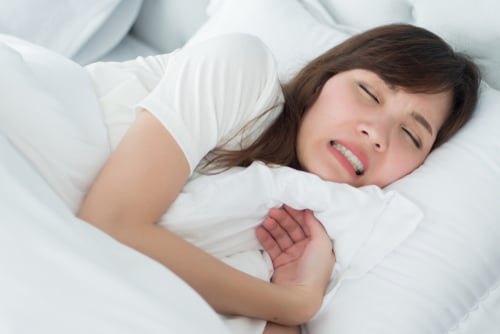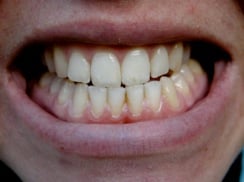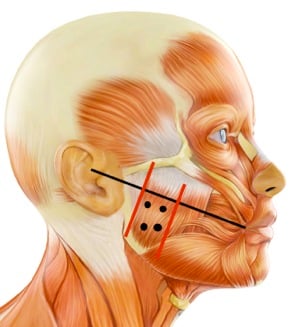Botox® for Bruxism: Effective Treatment Explained
By Dr. Stephen Cosentino
PRESIDENT OF EMPIRE MEDICAL TRAINING
How does Botox® treat Bruxism?
 Botox is an effective treatment for Bruxism as it works directly on the muscles involved in "clenching" your teeth. Botox is a neurotoxin that "paralyzes" or weakens the muscle by blocking the release of certain transmitters at the neuromuscular junction. By injecting Botox in the proper manner, location, depth, and using the correct dosage and following correct protocols, one can effectively treat Bruxism using a neuro blocking agent, like Botox.
During Empire Medical Training's Botox courses, attendees will learn the correct technique for treating patients with Bruxism. This is not a procedure that should be utilized without a thorough understanding of facial anatomy as an inadvertent penetration into incorrect facial landmarks can lead to nerve damage and other unwanted effects.
Bruxism (not to be confused with TMJ) refers to patients who excessively grind their teeth and clench their jaw either involuntarily (awake Bruxism) or during sleep (sleep Bruxism). It is estimated that over 30% of the population has this type of parafunctional activity which presents itself as a hypertrophic masseter muscle in the face.
Though we do not fully understand why people develop Bruxism its symptoms may include headaches, teeth sensitivity, and jaw muscle pain. Conventional treatments typically has been mouth guards to protect the teeth due to excessive tooth wear, breaks, or damaged restorations.
The immediate causes for Bruxism though it is hypothesized that it may involve a number of factors:
Botox is an effective treatment for Bruxism as it works directly on the muscles involved in "clenching" your teeth. Botox is a neurotoxin that "paralyzes" or weakens the muscle by blocking the release of certain transmitters at the neuromuscular junction. By injecting Botox in the proper manner, location, depth, and using the correct dosage and following correct protocols, one can effectively treat Bruxism using a neuro blocking agent, like Botox.
During Empire Medical Training's Botox courses, attendees will learn the correct technique for treating patients with Bruxism. This is not a procedure that should be utilized without a thorough understanding of facial anatomy as an inadvertent penetration into incorrect facial landmarks can lead to nerve damage and other unwanted effects.
Bruxism (not to be confused with TMJ) refers to patients who excessively grind their teeth and clench their jaw either involuntarily (awake Bruxism) or during sleep (sleep Bruxism). It is estimated that over 30% of the population has this type of parafunctional activity which presents itself as a hypertrophic masseter muscle in the face.
Though we do not fully understand why people develop Bruxism its symptoms may include headaches, teeth sensitivity, and jaw muscle pain. Conventional treatments typically has been mouth guards to protect the teeth due to excessive tooth wear, breaks, or damaged restorations.
The immediate causes for Bruxism though it is hypothesized that it may involve a number of factors:
- Anxiety (stress, anger, tension)
- Teeth alignment issues (malocclusion)
- Sleeping disorders
- Neurological disorders (i.e. Huntington’s or Parkinson’s)
- Reactions to medications (i.e. antidepressants, psych drugs)
- Mark from the Head (caput) of the condylar process (ear canal opening) of the ear to the corner commissure of the mouth using a marking pen. This will represent the zone of adherence as the Botox® injections to the Masseter muscle will be distal to these markings as you do not wish to inject the Masseteric fascia.
- The patient will clench their teeth together and you will palpate the masseter muscle and make markings medial and lateral to the muscle. The injections will be between these (2) markings as you wish to avoid the Buccinator muscle and Risorius muscle. The injection will also be above the base of the mandible.
- The dosing per injection is (4) units each at (4-5) injection points within the muscle (intramuscular). Isolation of the muscle is possible if you wish to pinch the muscle but can also be administered if resistance is felt at the injection point.
 Typically these injections are bi-lateral and the only possible complication or symptom after the injection is that the patient may feel fatigued when chewing after a prolonged period of time. For most patients, it is very well tolerated and the effects can last up to (6) months per treatment. Prolonged therapeutic use of Botox® for bruxism may also allow for effective treatments over (6) months since the muscle having been relaxed for long periods will not become quite as dominant and hypertrophic after extended periods of atrophy.
Typically these injections are bi-lateral and the only possible complication or symptom after the injection is that the patient may feel fatigued when chewing after a prolonged period of time. For most patients, it is very well tolerated and the effects can last up to (6) months per treatment. Prolonged therapeutic use of Botox® for bruxism may also allow for effective treatments over (6) months since the muscle having been relaxed for long periods will not become quite as dominant and hypertrophic after extended periods of atrophy.


